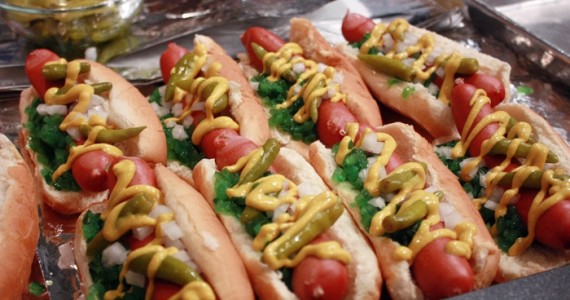Philly’s long been a low-key blip on the Great American Hot Dog Radar. Though we do have a signature style (the “Philly Combo” or “Surf and Turf,” consisting of a fried fish cake smashed on top of a link), our city doesn’t enjoy the national nitrate notoriety of cities like New York, Chicago or Detroit. Thankfully, there are a few locally based forcemeat figures working to change all that. Two of these frank fellows, illustrator and hot dog writer Hawk Krall and Hot Diggity! owner Keith Garabedian, recently stopped by COOK to take a small group of lucky hot dog fanatics on a tour through American wienerdom, making sure to celebrate Philly’s contributions to the field the whole way through.
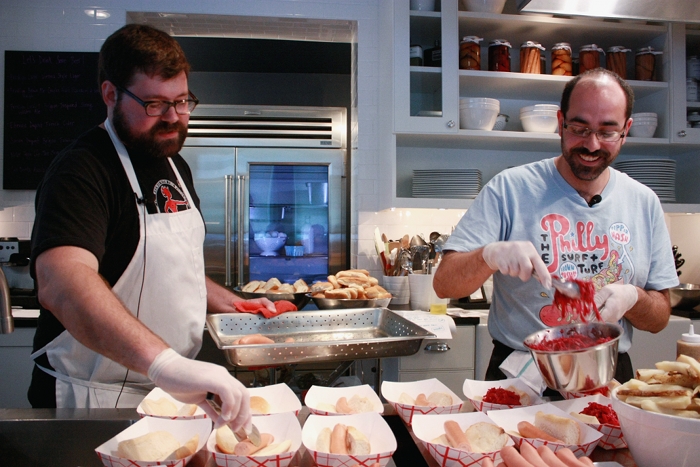
In addition to his unmistakable work as an illustrator, which was recently highlighted in Lucky Peach and can be found in a number of publications nationwide, Krall (above, left) has cooked in all kinds of kitchens, from down-and-dirty dives to fine-dining establishments. It’s where he first fell for dogcraft and the innumerable variations therein, leading to a regular gig as hot dog columnist for Serious Eats. His friend Garabedian (right, rocking an original Krall design on his shirt), meanwhile, is a professional chef who’s worked everywhere from the Tortilla Press in Collingswood to Tom Colicchio‘s Craftbar in NYC. After earning a doctorate in music theory (his “Dr. Hot Dog” Twitter persona = not much of a stretch), Garabedian returned to the area to join some good friends in opening Hot Diggity! on South Street in 2011. The cheery parlor, decorated with Krall’s drawings, specializes in spins on hot dog styles from around the nation — precisely the route the duo took with their spread at COOK.
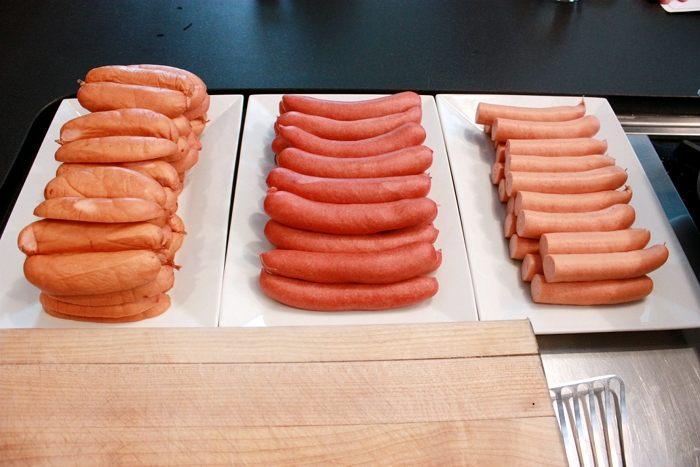
Though Diggity uses Sabrett’s franks and custom-baked Liscio’s rolls for its menu, Krall and Garabedian took painstaking efforts to ship hot dogs and rolls from around the country for their five-course class, which started off with a simple ice-breaking question: “What’s your favorite hot dog topping?” (Answers ranged from “electric relish” to cream cheese — more on both additions later.) To start, the dudes did Philly proud, bunning up a German-style 100% veal frankfurter from Northeast Philly stalwart Rieker’s Prime Meats with rotkohl (red cabbage) and homemade whole-grain mustard. To add a cheffy touch to the proceedings, Garabedian paired each course with his homemade sodas, all of which are available at his shop. This particular dog enjoyed a sidecar of cucumber, lovage, sassafras and sumac soda; Garabedian doesn’t like adding sweeteners to his drinks, allowing the oft-funky vegetal personalities of his pop ingredients to, well, pop.
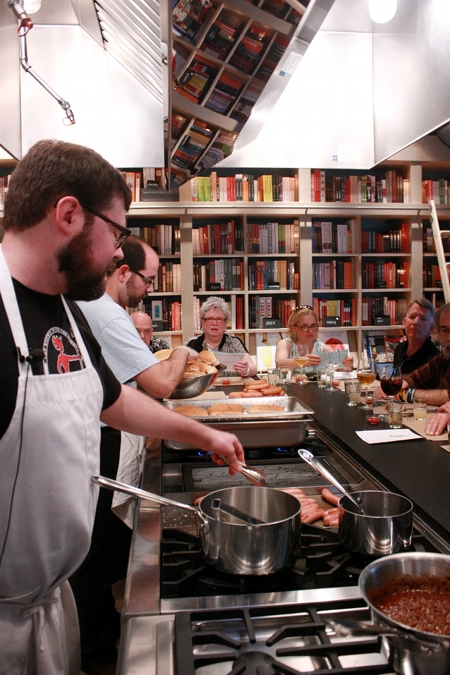
Second up for consumption: a Detroit Coney, featuring L-901 sausages from Winter’s. Though there is some historical confusion as to why this pure-Michigan style is named after an area in Brooklyn — some say it was inspired by the dogs served on the iconic peninsula, while proud Detroit natives argue that it has to do with a nearby amusement park inspired by Coney Island (confusing, we know) — there’s no disputing what goes on the dog itself. That would be chopped raw white onion, mustard and beef heart chili, which Garabedian made from scratch using local free-range grass-fed beef hearts and Eastern European spices like paprika, cinnamon and allspice. This incredible stuff is also known as “Greek Sauce,” a shout to the hard-working Greek immigrant vendors who effectively spread hot dogs across the nation in the early 20th century.
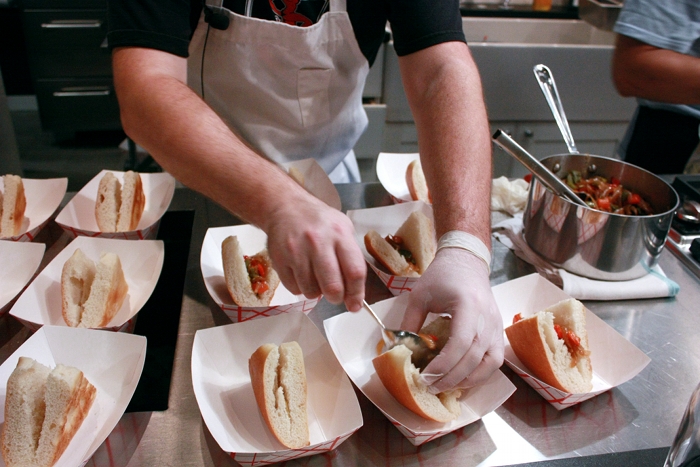
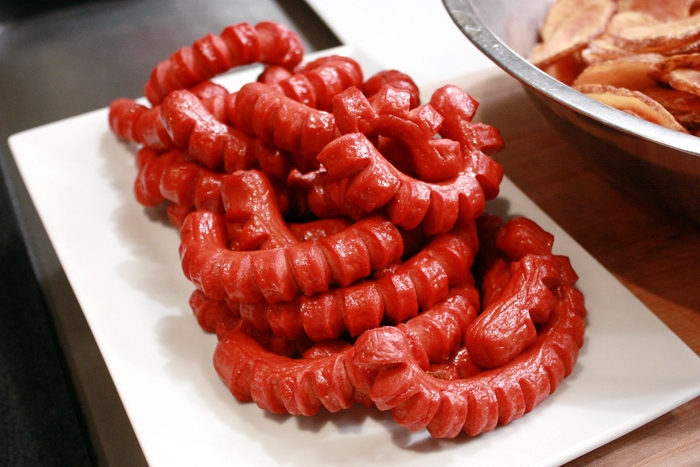
Krall and Garabedian presented two fiercely regional dog styles for courses three and four, starting with what’s called a “Chicago Depression Dog” (top photo), a Vienna Beef natural-casing frank adorned with spicy “sport peppers,” mustard, onions and the aforementioned “electric relish” (so named because it’s dyed a vivid green AstroTurf-y color). Oh, and a generous handful of Garabedian’s insane thick-cut French fries, too. The name comes from vendors in the Windy City during the Great Depression, who would wrap these portable meals up with fries in butcher paper, allowing the heat from the taters to steam the bun. It’s worth noting that a Depression dog is its own distinct thing, separate from the poppy-seed bun, celery salt, pickle spear style most ID as a Chicago dog. (Americans are incredibly protective of this stuff, so it behooves us to include this disclaimer so none of you go chasing these guys down the street with old brooms because they violated biblical hot-dog law.)
Traveling closer to home, the guys purchased both meat and bread from North Jersey for their Italian hot dog (above), a sliced-and-fried tubesteak from Newark’s Best Provision wedged with fried potatoes, peppers and onions into real-deal “pizza bread,” which falls somewhere between foccacia and a muffuletta roll in the consistency department. Even though Philly’s not that far from North Jerz, this is one particular dog type that’s never spread beyond its home in the manner Chitown dogs have; interestingly, we hear Garabedian is in talks with a local pizzeria to bake him authentic pizza bread, which would allow him to add an Italian dog to the Diggity menu.
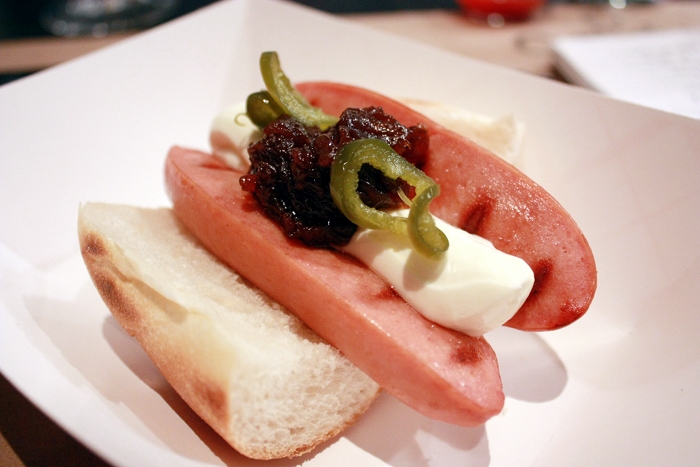
The last hot dog of the evening was perhaps the one most unfamiliar to the crowd: a Seattle-style specimen featuring a split Polish sausage squiggled with whipped cream cheese and finished with caramelized onions deglazed with Coca-Cola (!) and slivers of jalapeno. What’s most interesting about this guy, shmear-on-a-damn-wiener notwithstanding, is that it’s perhaps the “newest” of the American regional dog styles. Industrial enclaves like NYC and Detroit and have simply been around a lot longer, allowing for much more storied culinary development; since the Emerald City, founded in 1851, is relatively young by comparison, their contributions to the scene are only beginning to turn heads.
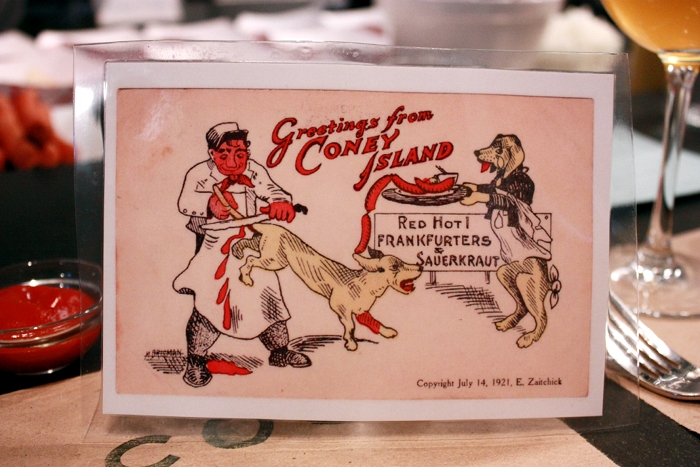
In addition to breaking down the particulars of their menu, Krall and Garabedian also shared their extensive knowledge of domestic hot dog history as a whole, which, if you can’t tell from the postcard above, is EXTREMELY DARK AND DISTURBING. Since the hot dog as we know it today descended from the Germanic meat traditions of European immigrants, racism played a role in the prejudicial treatment of these new arrivals to the country — many of whom were able to make an immediate living as street food vendors. The persistent modern-day rumors you hear about wieners literally being made with dog meat (a la above), or “lips and assholes,” are emblematic of this xenophobic mentality. Funny, then, that dogs are nowadays considered one of America’s quintessential foods. It’s always nice when We the People can agree on something, especially when it tastes this good.
Photos: Drew Lazor
Back to Blog
